|
|
|
Sort Order |
|
|
|
Items / Page
|
|
|
|
|
|
|
| Srl | Item |
| 1 |
ID:
130888
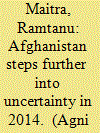

|
|
|
|
|
| Publication |
2014.
|
| Summary/Abstract |
2014 was long anticipated as the year of transition and ushering in of hope for Afghanistan. Three months of this important year are already behind us and, betraying earlier expectations, afghans continue to face stark uncertainties.
|
|
|
|
|
|
|
|
|
|
|
|
|
|
|
|
| 2 |
ID:
156092
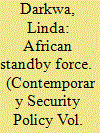

|
|
|
|
|
| Summary/Abstract |
Declared operationally ready in 2016, the African Standby Force (ASF) has not been deployed in its originally designed form. This is not for the lack of opportunities but rather a demonstration of the power of the Regional Economic Communities/Regional Mechanisms (RECs/RMs) – Africa’s sub-regional security structures – over matters of peace and security. Experience gathered from its short existence suggests that the ASF may never be deployed in its current form. It may instead evolve into a robust framework, adaptable mainly by the RECs/RMs, for addressing varied security challenges. Four things are critical to enhancing the utility of the ASF: the political willingness of the RECs/RMs, the strategic interest of the member states, predictable and sustainable financing, and clarity on the role of the African Capability for Immediate Response to Crisis, the temporary battlegroup that was created to provide the African Union with a rapid response capability, pending the ASF’s operationalization.
|
|
|
|
|
|
|
|
|
|
|
|
|
|
|
|
| 3 |
ID:
130897
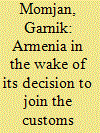

|
|
|
|
|
| Publication |
2014.
|
| Summary/Abstract |
I will speak about the situation in Armenia. On September 3, 2013 at the meeting with President Putin in Moscow, our President Serzh Sargsyan announced that Armenia would join the custom union. This statement echoed all over the world : in the evening, all leading information agencies and the media - BBC, Euronews and the Wall Street Journal were discussing it; they concluded that Russia had put pressure on Armenia.
|
|
|
|
|
|
|
|
|
|
|
|
|
|
|
|
| 4 |
ID:
134047
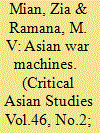

|
|
|
|
|
| Publication |
2014.
|
| Summary/Abstract |
The South Asian security landscape is increasingly dominated by a complex four-way dynamic between India, Pakistan, China, and the United States. The stresses and strains of the relationships between these states directly affect the prospects for peace and prosperity for almost half of humanity. This article describes some of the military contours of this landscape, with a focus on strategic postures, weapon acquisitions, and the role of nuclear weapons. It maps the India-Pakistan arms race over the past decade, the economic constraints on the two states, the role of China and the United States as weapons suppliers, and the risk and consequences for nuclear war. The authors then look at India's relationship with China, which is marked by both cooperation and competition, and the rise of China as a close military, political, and economic ally of Pakistan. While the United States has had long-standing cooperative relationships with both India and Pakistan, these relationships have been undergoing major shifts over the last two decades. U.S. concerns about China's increasing military and economic power have also intensified over this period as well. Of particular significance has been the effort to create a U.S.-India strategic partnership to balance and contain a rising China, which may become a central feature of the emerging global order. This article also offers a brief overview of what is publicly known about the nuclear arsenals of the four countries, ongoing production of weapons-usable fissile materials in Pakistan and India, as well as the race to build longer-range missiles.
|
|
|
|
|
|
|
|
|
|
|
|
|
|
|
|
| 5 |
ID:
124432
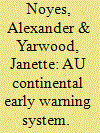

|
|
|
|
|
| Publication |
2013.
|
| Summary/Abstract |
Despite criticism from scholars, the Continental Early Warning System (CEWS) at the African Union (AU) has recently made significant progress in its capacity to monitor, analyse, and provide warning of impending conflict situations in Africa. However, CEWS remains constrained by human resource limitations, inchoate cooperation and information sharing with the early warning efforts of regional organizations, and unsystematic coordination with the various AU organs focusing on peace and security. Additionally, although the early warning-early response gap is narrowing at the AU, early response mechanisms continue to be constrained by limited capacity and issues of political will, as high-level political disagreements and issues of sovereignty militate against effective preventive action. Based on over two-dozen interviews with senior-level CEWS and AU officials, along with other relevant stakeholders, this paper highlights recent operational progress, identifies remaining gaps, and forwards policy options for the AU and international community to build on the gains of CEWS.
|
|
|
|
|
|
|
|
|
|
|
|
|
|
|
|
| 6 |
ID:
130964
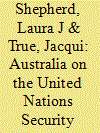

|
|
|
|
|
| Publication |
2014.
|
| Summary/Abstract |
Until 2015, Australia is uniquely positioned on the world stage to make a real difference to women's lives in conflict, transitional and post-conflict countries by ensuring they are actively represented in all peace negotiations1. The Australian government has secured not only a non-permanent seat on the United Nations Security Council (UNSC), but also a seat on the Executive Board of UN Women, the UN entity charged with enhancing gender equality and the empowerment of women. These represent two internationally significant avenues through which the Australian government can fulfil its promise to engage women in the governance of international peace and security, furthering the UN's Women, Peace and Security (WPS) agenda. This agenda, the primary architecture of which comprises seven interrelated UNSC Resolutions dating back to UNSC Resolution 1325 (2000), mandates that women should be represented at and actively participate in all peace negotiations, as well as making binding international commitments to eliminate violence against women and protect women's rights
|
|
|
|
|
|
|
|
|
|
|
|
|
|
|
|
| 7 |
ID:
133579
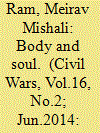

|
|
|
|
|
| Publication |
2014.
|
| Summary/Abstract |
The study presents an integrated model which places the link between the competing state-centric and sub-state explanations of civil strife. As state's capacity and communal fractionalization are typically tested in separate models, the combined framework aims to examine the premise of this article, that communal attributes affect the extent to which state capacity matters in preserving peace and security. The empirical analysis includes 1,385 instances of intrastate conflicts that occurred in 116 countries between 1995 and 2006, drawn from the Major Episodes of Political Violence and the Intra-State War datasets. The results of the study indicate that indeed the weakness of the body is substituted by the strength of the soul: the decline in state authority makes a larger room to sub-state groups, which shape internal dynamics. The second goal of the study is focused on the multifaceted nature of communal traits. Accordingly, the latter part the article offers an actor-oriented analysis, observing the relations between different ethnopolitical groups and violent strife. Based on the qualitative group assessment of the Minorities at Risk project, the study puts to test the argument that not all ethnic groups are alike in their potential to fracture communal solidarity and ignite civil war.
|
|
|
|
|
|
|
|
|
|
|
|
|
|
|
|
| 8 |
ID:
131026
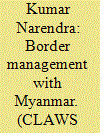

|
|
|
|
|
| Publication |
2014.
|
| Summary/Abstract |
Neighbouring states are most relevant in foreign policy' and Myanmar, indeed, has strategic, economic, cultural and religious signi?cance for India. Myanmar is not where only China and India 'meet'; it is also the intersection between South Asia and Southeast Asiaz. It is a gateway to South Asia and a land bridge to the Association for Southeast Asian Nations (ASEAN). It is an opportunity and also brings with it a certain amount of vulnerabilities as well. Myanmar has huge potential for meeting India's energy requirement and for markets for Indian consumer goods; in return, India can contribute immensely in the field of infrastructure development, communication, education, tourism industry, science and technology. India and Myanmar are historically linked to each other through religion, people-to-people contact and sharing ethnically identical populations on both sides of the borders. The porous land borders of India and Myanmar are a cause of concern for peace, stability and economic development. Inhospitable terrain and an underdeveloped border region provide an ideal platform for insurgents, non-state actors, drugs and weapons traffickers to operate and spread their network
|
|
|
|
|
|
|
|
|
|
|
|
|
|
|
|
| 9 |
ID:
178723
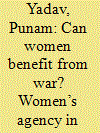

|
|
|
|
|
| Summary/Abstract |
Women’s agency in Peace and Conflict Studies has received increased policy attention since the formulation of UN Security Council Resolution in 2000. Academic attention regarding this question has, as a result, also increased dramatically in the intervening period. Women today, as a consequence, are not just seen as victims of conflict, but also as agents of change. Despite their vulnerabilities in the situations created by conflict, women may be exposed to new knowledge and opportunities, which may have positive impacts on their lives. Therefore, it is important to recognize the lived realities and the multiple stories of postwar societies to address the new needs of people and build a sustainable peace. This article examines the everyday lives of women in post-conflict Nepal to demonstrate the significant transformations that have taken place since the war. It specifically investigates conflict-induced social and structural changes through the lived experiences of women tempo drivers, war widows, women ex-combatants and women politicians. This article is based on the analysis of 200 interviews and six focus group discussions (FGDs) carried out over a period of 12 years in seven districts of Nepal.
|
|
|
|
|
|
|
|
|
|
|
|
|
|
|
|
| 10 |
ID:
131121
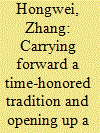

|
|
|
|
|
| Publication |
2014.
|
| Summary/Abstract |
At the beginning of 2014, China's Foreign Minister Wang Yi visited Ethiopia, Djibouti, Ghana and Senegal. During the trip, Wang stated China's readiness to work with Africa to realize their dreams of renewal, pursue development and prosperity, and promote peace and security. He also stressed China's commitment to equality, pragmatism, good faith and sincerity in China-Africa cooperation. According to Wang, China is actively involved in Africa's peace and security affairs, the balanced approach to principles and interests is a banner in China's diplomacy in the new era, and Pan-Africanism points the direction for Africa and represents the trend of the times.
|
|
|
|
|
|
|
|
|
|
|
|
|
|
|
|
| 11 |
ID:
076057
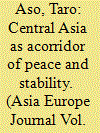

|
|
|
| 12 |
ID:
124876
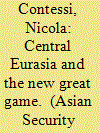

|
|
|
|
|
| Publication |
2013.
|
| Summary/Abstract |
In the 20 years since independence from the former Soviet Union, the study of Eurasia in International Relations (IR) has received considerable impetus in both the academic and policy circles. Specialized news and analysis outlets have come online, research centers have multiplied within universities, and a variety of think tanks now host dedicated programs. In other words, this still relatively little-known region has glamour. Yet Eurasia remains difficult to situate as an object of study due to its distinctive hybridity: geographical, at the crossroads between Europe and Asia; cultural, Muslim Russianspeaking Turkic peoples with Asian traits and traditions; political, straddling Western and Asian institutional forms domestically, and contiguous to Europe, Asia, Russia, the Middle East, and Afghanistan internationally. Partly as a result of this hybridity, Eurasia is a somewhat elusive object of study. At a minimum, it comprises the two subregions on each shore of the Caspian basin: Central Asia to the east and the Caucasus to the west. Reflecting this elusiveness, Central Asian states (CAS) belong to the Asia-Pacific Regional Group at the United Nations; they are members of the Asian Development Bank and the Economic Commission for the Asia-Paci?c. At the same time, they are members of the Organization for Security and Cooperation in Europe (OSCE), the European Bank for Reconstruction and Development, and the Euro-Atlantic Partnership Council, a North Atlantic Treaty Organization (NATO) ancillary forum. But they also have distinctly Central Asian groupings, such as the Eurasian Development Bank, the UN-af?liated Central Asian Regional Information and Coordination Center, not to mention the Shanghai Cooperation Organization (SCO) and Collective Security Treaty Organization (CSTO). Similarly, the three Caucasian states share most of the same af?liations, except for belonging to the East European Regional Group at the UN
|
|
|
|
|
|
|
|
|
|
|
|
|
|
|
|
| 13 |
ID:
157393
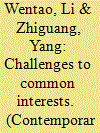

|
|
|
|
|
| Summary/Abstract |
The African economy, with average annual growth of 5% during 1995 to 2014, greatly interests investors but the current security situation hampers regional development and foreign direct investment.Investment in Africa has featured high return and high risk historically, and it remains clear that no single entity can properly solve current security challenges that Africa faces. the moment calls for international joint collaboration and concerted effort on the part of China, the US and African countries.
|
|
|
|
|
|
|
|
|
|
|
|
|
|
|
|
| 14 |
ID:
189657
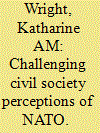

|
|
|
|
|
| Summary/Abstract |
Engagement with the Women, Peace and Security (WPS) agenda by military actors has caused concern among some of its civil society advocates. For example, NATO has adopted the WPS agenda as an increasingly visible part of its self-narrative. Yet what had distinguished NATO’s engagement with WPS from many other actors is that it came without civil society involvement. The establishment of a Civil Society Advisory Panel (CSAP) on WPS in 2014 is therefore highly significant for both NATO and the WPS agenda. Despite this, the efficacy of such consultation is not clear-cut nor its potential to mitigate militarised understandings of WPS and support transformative engagement with the agenda, particularly given the wariness of some civil society to engage with NATO. Drawing on interviews with civil society, this article interrogates their perceptions of NATO in order to understand the potential of such engagements to support transformative understandings of WPS and more broadly the efficacy of civil society engagement with military institutions. In so doing, it examines how such consultation adds to our understanding of NATO as an institution of international hegemonic masculinity.
|
|
|
|
|
|
|
|
|
|
|
|
|
|
|
|
| 15 |
ID:
133576
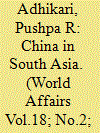

|
|
|
|
|
| Publication |
2014.
|
| Summary/Abstract |
India has reason to fear Chinese encirclement, while the growing assertiveness and self-confi dence of the PLA is a cause for concern. Head-on confrontation between the two could largely destroy these ancient civilisations, while the prospect for peace could bring prosperity to not only South Asia, but the greater Asian region as a whole. Pushpa R Adhikari asserts that building confi dence and cooperation between all states in the region is vital for its progress and stability.
|
|
|
|
|
|
|
|
|
|
|
|
|
|
|
|
| 16 |
ID:
068723
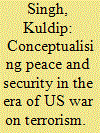

|
|
|
| 17 |
ID:
175364
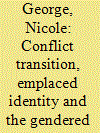

|
|
|
|
|
| Summary/Abstract |
Although there is growing recognition that women’s participation is critical for the durability of peaceful conflict transition, grounded research examining the political scale of women’s participation has not been common. Where feminist researchers have tackled this topic, they have generally reproduced binary representations of political space, sometimes strongly critical of local spaces as restrictive of women, sometimes strongly critical of a hegemonic liberal international. In this article, I address the issue of women’s participation in conflict transition governance from another more ethnographic angle, drawing from fieldwork conducted in the Solomon Islands, a Pacific Islands country destabilised by conflict in the late 1990s and early 2000s. I apply theories of political scale to consider where and how women are politically active in the conflict transition environment, how that political activity is constituted relative to other political scales and where and how women seek to make their political ambitions understood. The ‘emplacement’ lens I develop offers a critical vantage point for analysis of the ways women constitute political identities and the agendas they might meaningfully progress, at scales ranging from the small worlds of the household and the community to the broader scale of national politics.
|
|
|
|
|
|
|
|
|
|
|
|
|
|
|
|
| 18 |
ID:
127776
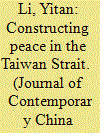

|
|
|
|
|
| Publication |
2014.
|
| Summary/Abstract |
Economic integration in the Taiwan Strait has become increasingly stronger recently. Economic integration should have led to stronger political convergence. Why hasn't it occurred? I argue that democracy in Taiwan and the continuation of the single-party rule in China have created two very different social experiences. These different social experiences have formed two different identities. People in Taiwan are increasingly thinking of themselves as Taiwanese rather than Chinese. The growing level of popular nationalism in China has also altered the political identity of mainland Chinese. Such change could force Beijing to accommodate citizens' demand to act more toughly towards Taipei. Further political integration is still possible, but it would require another norm change, perhaps already in the making.
|
|
|
|
|
|
|
|
|
|
|
|
|
|
|
|
| 19 |
ID:
193149
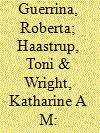

|
|
|
|
|
| Summary/Abstract |
Since 2014, several European Union (EU) member states have adopted their own versions of “Feminist Foreign Policy” (FFP). Increasingly, feminist bureaucrats, politicians, activists and scholars are calling for the EU to do the same. This article scrutinises claims to the feminist actorsness of the EU by introducing the analytical concept of Feminist Power Europe (FPE). In employing FPE the article examines whether the EU can adopt a FFP that upholds transformative potential of feminism. Undertaking critical content analysis of key documents, we identify three overarching feminist frames that emerge in the EU’s external policies: (1) Liberal; (2) Intersectional; (3) Postcolonial. We demonstrate that the EU’s propensity for a transformative feminist foreign policy is limited by the setup of global politics and the main drivers of European integration, which continue to be situated in a traditionally masculine environment and are defined by prevailing hierarchies. In undertaking this work, we highlight the constraints of advocating for the EU to adopt a FFP. This paper concludes by cautioning against the uncritical deployment of “feminism” in foreign policy articulation within an FPE configuration that excludes reflexivity about the EU’s external relations vision and indeed, its practice.
|
|
|
|
|
|
|
|
|
|
|
|
|
|
|
|
| 20 |
ID:
130891
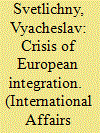

|
|
|
|
|
| Publication |
2014.
|
| Summary/Abstract |
Conferences organized by the journal in Yalta have already become a good tradition. It will be needless to speak of the significance that the Crimean land has for us: historically, ethnically, and mentally. Crimea is always a special place for Russia. There is no other area outside of Russia where so many Russian people live - Russian not only by ethnic origin, not only by blood, but also by spirit and mentality. We often
hear that Ukraine is going its own way, in accordance with its national interests. Of course, the choice of way is the right of every sovereign state. But many keep wondering about this. For example, at a recent meeting with local political analysts, the Chairman of the Council of Ministers of the Autonomous Republic of Crimea, Anatoly Mogilev, put the following question to the audience: "Will the signing of
the document in Vilnius become an irritating factor for Crimean society and lead to a destabilization of the situation?" The question is how to avoid de stabilization because nobody, whether in Moscow or in Kiev or especially in Crimea, is interested in it. No prediction of public behavior in this situation is yet available and we are looking forward to recommendations from the expert community.
|
|
|
|
|
|
|
|
|
|
|
|
|
|
|
|
|
|
|
|
|